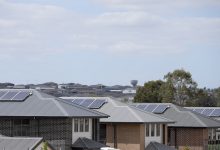As Australia surpasses three million rooftop solar installations, households looking to buy a battery storage system or electric vehicle can be part of a new kind of power plant bringing about faster, cheaper decarbonisation.
In the future, so-called “virtual power plants” that harvest distributed renewable electricity and demand response will play a major role.
A virtual power plant (VPP) is a network of distributed energy resources – not just rooftop solar, but also batteries, electric vehicles and smart appliances – working as a single power source and aggregated via software to participate in energy markets.
VPPs create the opportunity for cheaper, faster decarbonisation than only building large-scale generation and storage.
They do that by leveraging consumers’ investments to benefit the system as a whole, speeding up the payback period for households and businesses, and reducing the overall system cost of new renewable generation and storage.
In general, the greatest value in rooftop solar and battery storage is in providing behind-the-meter (BTM) on-site electricity supply, co-locating generation and load, while avoiding network and retail costs.
As the capacity of rooftop solar systems and batteries increases and the cost decreases – and if electricity demand can be harnessed through smart controllers – there is the potential for behind-the-meter resources to provide significant supply and demand response to meet the needs not just of households and businesses, but for the broader electricity system.
Three years ago, the Australian Energy Market Operator (AEMO) predicted there could be 700 megawatts (MW) of VPPs by 2022 – on IEEFA’s estimate, the figure is nearer 300MW for households in the National Energy Market.
The potential of VPPs is yet to be realised. There is a lack of significant revenue for distributed energy resource owners or VPP providers.
Households are currently only being paid around $200/year for the use of their battery by aggregators to participate in energy and ancillary services markets. The margins are thin.
However, VPPs are the future of energy retailing. VPP providers (aggregators and retailers) aiming for future profits will increasingly see the value in investing in VPP software and systems.
The greatest potential – and the reason we believe that so many retailers are moving to sell VPP products – is that larger batteries, especially in the form of EVs, will unlock much greater behind-the-meter (BTM) capacity.
EV batteries are currently six to 10 times larger than standard household batteries and will be able to store abundant rooftop solar, making it available at any time.
The other massive, largely untapped opportunity is for commercial and industrial (C&I) VPPs to draw on the growing fleet of rooftop solar, battery storage and energy management systems atop and within factories, offices and warehouses.
In March 2022, Origin Energy announced plans to expand its in-house VPP ten-fold from 205MW to 2,000MW within four years, aiming to fulfill customers’ expectations for lower costs, decarbonisation and energy autonomy, with less churn an advantage for Origin.
Origin clearly understands the value of distributed energy resources. To secure their future, retailers should offer the combination of rooftop solar, batteries, managed EV charging while being a VPP-tailer for both residential and commercial customers.
VPPs have relatively low establishment costs in comparison with large generators and transmission and they are fast to establish.
Origin realises that it can leverage billions of dollars of household and business investment in smart energy to quickly provide clean capacity to the national electricity market. Another twenty retail and aggregation businesses are looking to scale to do the same.
Whereas previously the largest retailers owned large generators, with profitability tied to “gentailing”, we see the future of retail being in “VPP-tailing”.
Inevitably at least two-thirds of Australian households will purchase rooftop solar and either a stationary battery or an EV or two, or both. That will mean that most of the supply to these households will be behind-the-meter and they will have spare capacity available to sell directly and via a battery to the rest of the grid.
Unless a retailer has a relationship with households that enables access to these behind-the-meter resources, they will be left with only a small proportion of households to retail to, as well as no access to these valuable distributed energy resources.
We would go so far as to suggest that in future, retailers without VPP capabilities will struggle to be profitable. Income from sales from the grid will continue to fall.
At the same time, the volume of exports from distributed energy resources will increase, creating opportunities for DER aggregators able to harness this fleet for wholesale and FCAS market participation. Along the way there will be commercial opportunities in selling solar, batteries and EVs and financing these purchases.
Unfortunately, Australia’s energy market institutions are not treating distributed energy resources or VPPs with the same seriousness as companies like Origin are doing.
Consumers and the industry need national policy and regulation which prioritises equitable treatment for distributed energy resources with large-scale generation and storage.
You can read a new IEEFA report on this here: What Is the State of Virtual Power Plants in Australia? From Thin Margins to a Future of VPP-tailers
Dr Gabrielle Kuiper is a DER specialist and an IEEFA guest contributor








